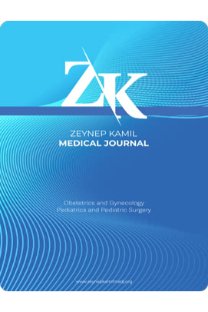Dysfunctional Elimination in Children Operated for Sacrococcygeal Teratoma
___
1. Tapper D, Sawin R. Teratomas and Other Germ Cell Tumors. In: ONeill JA, Rowe MI, Grosfeld JL, Fonkalsrud EW, Coran AG. Pediatric Surgery. 5th ed. St Louis. CV Mosby; 1998; 447-9.2. Başaklar AC. Teratom. In: Başaklar AC. Bebek ve Çocukların Cerrahi ve Ürolojik Hastalıkları, 1st ed. Ankara: Palme Yayıncılık; 2006; 1889-906.
3. Teilum G. Classification of endodermal sinus tumour (mesoblastoma vitellinum) and so called embryonal carcinoma of the ovary. Acta Pathol Microbiol Scand 1965; 64: 407- 29.
4. Pantanowitz L, Jamieson T, Beavon I. Pathobiology of sacrococcygeal teratomas. S Afr J Surg 2001; 39: 56-62.
5. Brown NJ. Teratomas and yolk sac tumours. J Clin Pathol 1976; 29: 1021 5.
6. Altman RP, Randolph JG, Lilly JR. Sacrococcygeal teratoma: American Academy of Pediatrics Surgical Section Survey-1973. J Pediatr Surg 1974; 9: 389-98.
7. Boemers TM. Urinary incontinence and vesicourethral dysfunction in pediatric surgical conditions. Semin Pediatr Surg 2002; 11: 91-9.
8. Billmire DF, Grosfeld JL. Teratomas in childhood: analysis of 142 cases. J Pediatr Surg 1986; 21: 548-51.
9. Tapper D, Locke EE. Teratomas in infancy and childhood: A 54-year experience at the Childrens Hospital Medical Center. Ann Surg 1983; 198: 398-410.
10.Makin EC, Hyett J, Ajayi NA, Patel S, Nicolaides K, Davenport M. Outcome of antenatally diagnosed sacrococcygeal teratomas: single-center experience (1993-2004). J Pediatr Surg 2006; 41: 38893.
11. Rescorla FJ, Sawin RS, Coran AG, et al. Long-term outcome for infants and children with sacrococcygeal teratoma: a report from the Childrens Cancer Group. J Pediatr Surg 1998; 33: 171-6.
12. Laberge JM, Nguyen LT, Shaw KS. Teratomas, Dermoids and Other Soft Tissue Tumors. In: Aschcraft KW, Murphy JP, Sharp RJ, Sigalet DL, Snyder CL. Pediatric Surgery. 3rd ed. Philadelphia. WB Saunders; 2000; 905-26.
13. Bittmann S, Bittmann V. Surgical Experience and Cosmetic Outcomes in Children with Sacrococcygeal Teratoma. Current Surgery. 2006; 63: 51-4.
14. Bass J, Luks F, Yazbeck S. Long-term follow-up of sacrococcygeal teratomas with emphasis on anorectal function. Pediatr Surg Int 1991; 6: 119-21.
15. Schmidt B, Haberlik A, Uray E, et al. Sacrococcygeal teratoma clinical course and prognosis with a special view to long-term functional results. Pediatr Surg Int 1999; 15: 573-6.
16. Wooley MM. Teratomas. In: Ashcraft KW, Holder TM. Pediatric Surgery. 2 nd ed. Philadelphia, PA: Saunders pp; 1992; 847-62.
17. Malone PS, Kiely EM, Brereton RJ, et al. The functional sequelae of sacrococcygeal teratoma. J Pediatr Surg 1990; 25: 679-80.
18. Boemers TM, Gool JD, Jong TP, Bax KM. Lower urinary tract dysfunction in children with benign sacrococcygeal teratoma. J Urol 1994; 151: 174-6.
19. Engelskirchen R, Holschneider AM, Rhein R, et al. Sacrococcygeal teratomas in children: an analysis of longterm results in 87 cases. Z Kinderchir 1987; 18: 294-361.
20. Malone PS, Spitz L, Kiely EM, et al. The functional sequelae of sacrococcygeal teratoma. J Pediatr Surg 1990; 25: 679-80.
21. Havranek P, Hedlund H, Rubenson A, et al. Sacrococcygeal teratoma in Sweden between 1978 and 1989: long-term functional results. J Pediatr Surg 1992; 27: 916-8.
22. Derikx JPM, Backer AD, Schoot L, Aronson DC, Langen ZJ, Hoonaard TL, Bax NMA, Staak F, Heurn LWE. Long-term functional sequelae of sacrococcygeal teratoma: A national study in the Netherlands. Journal of Pediatric Surgery. 2007; 42: 1122 6.
23. Kirk D, Lister J. Urinary complications of sacrococcygeal teratoma. Z Kinderchir 1976; 18: 294-304.
24. Lahdenne P, Wikstrõm S, Heinheimo M, Martiinen E, Siimes MA. Late urological sequelae after surgery for congenital sacrococcygeal teratoma. Pediatr Surg Int 1992; 7: 195-8.
- ISSN: 1300-7971
- Yayın Aralığı: 4
- Başlangıç: 1969
- Yayıncı: Ali Cangül
Nekrotizan Enterokolit Olgularında Erken Drenajın Sağkalıma Etkisi
N GÜLÇİN, A.C CELAYİR, C. ŞAHİN, G KURT, O BOSNALI, S MORALIOĞLU
Sadık ŞAHİN, Mustafa EROĞLU, Kadir GÜZİN, Mustafa S. YAŞARTEKİN
Taner GÜNAY, MEHMET AKİF SARGIN, Işıl BAKIRCI TURAN, Mehmet BAYRAK, Gökçen ÖRGÜL, Özgür Aydın TOSUN, Alpaslan AKYOL
S AFSAR, A DİLLİ, M. EROĞLU, S. ŞAHİN
S AFSAR, A DİLLİ, M. EROĞLU, S. ŞAHİN
Elif AĞAÇAYAK, Ali ÖZLER, Senem TUNÇ YAMAN, Abdulkadir TURGUT
Taner GÜNAY, MEHMET AKİF SARGIN, Işıl Turan BAKIRCI, Mehmet BAYRAK, Özgür Aydın TOSUN, Gökçen ÖRGÜL
Akut Apandisiti Taklit Eden Apandiks Endometriozisleri: 2 Olgu
Mehmet ESER, Semra KAYATAŞ, Aylin ACAR, Kayhan BAŞAK, LEVENT KAPTANOĞLU
NURDAN DEMİRCİ, Hacer ATAMAN, YILDA ARZU ABA, FATMA BAŞAR, Filiz ÖZKA
Muharrem BOSTANCI, Zehra Esra ÖNAL, Suna HANCİLİ, Duygu BAYOĞLU SÖMEN, Çağatay NUHOĞLU
